Liancheng Fang
A Survey on Parallel Text Generation: From Parallel Decoding to Diffusion Language Models
Aug 12, 2025Abstract:As text generation has become a core capability of modern Large Language Models (LLMs), it underpins a wide range of downstream applications. However, most existing LLMs rely on autoregressive (AR) generation, producing one token at a time based on previously generated context-resulting in limited generation speed due to the inherently sequential nature of the process. To address this challenge, an increasing number of researchers have begun exploring parallel text generation-a broad class of techniques aimed at breaking the token-by-token generation bottleneck and improving inference efficiency. Despite growing interest, there remains a lack of comprehensive analysis on what specific techniques constitute parallel text generation and how they improve inference performance. To bridge this gap, we present a systematic survey of parallel text generation methods. We categorize existing approaches into AR-based and Non-AR-based paradigms, and provide a detailed examination of the core techniques within each category. Following this taxonomy, we assess their theoretical trade-offs in terms of speed, quality, and efficiency, and examine their potential for combination and comparison with alternative acceleration strategies. Finally, based on our findings, we highlight recent advancements, identify open challenges, and outline promising directions for future research in parallel text generation.
A Call for Collaborative Intelligence: Why Human-Agent Systems Should Precede AI Autonomy
Jun 11, 2025Abstract:Recent improvements in large language models (LLMs) have led many researchers to focus on building fully autonomous AI agents. This position paper questions whether this approach is the right path forward, as these autonomous systems still have problems with reliability, transparency, and understanding the actual requirements of human. We suggest a different approach: LLM-based Human-Agent Systems (LLM-HAS), where AI works with humans rather than replacing them. By keeping human involved to provide guidance, answer questions, and maintain control, these systems can be more trustworthy and adaptable. Looking at examples from healthcare, finance, and software development, we show how human-AI teamwork can handle complex tasks better than AI working alone. We also discuss the challenges of building these collaborative systems and offer practical solutions. This paper argues that progress in AI should not be measured by how independent systems become, but by how well they can work with humans. The most promising future for AI is not in systems that take over human roles, but in those that enhance human capabilities through meaningful partnership.
A Survey on Large Language Model based Human-Agent Systems
May 01, 2025Abstract:Recent advances in large language models (LLMs) have sparked growing interest in building fully autonomous agents. However, fully autonomous LLM-based agents still face significant challenges, including limited reliability due to hallucinations, difficulty in handling complex tasks, and substantial safety and ethical risks, all of which limit their feasibility and trustworthiness in real-world applications. To overcome these limitations, LLM-based human-agent systems (LLM-HAS) incorporate human-provided information, feedback, or control into the agent system to enhance system performance, reliability and safety. This paper provides the first comprehensive and structured survey of LLM-HAS. It clarifies fundamental concepts, systematically presents core components shaping these systems, including environment & profiling, human feedback, interaction types, orchestration and communication, explores emerging applications, and discusses unique challenges and opportunities. By consolidating current knowledge and offering a structured overview, we aim to foster further research and innovation in this rapidly evolving interdisciplinary field. Paper lists and resources are available at https://github.com/HenryPengZou/Awesome-LLM-Based-Human-Agent-System-Papers.
TestNUC: Enhancing Test-Time Computing Approaches through Neighboring Unlabeled Data Consistency
Feb 26, 2025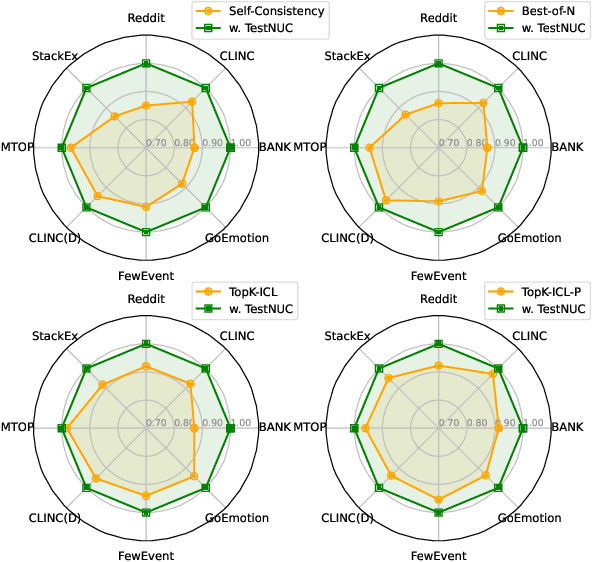
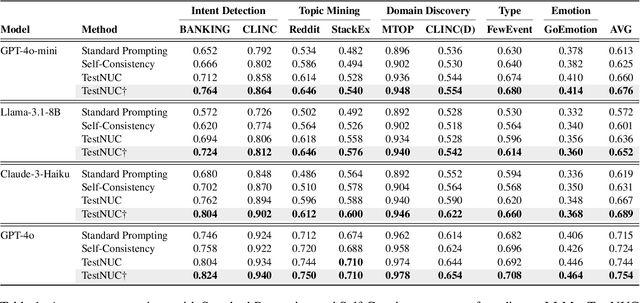
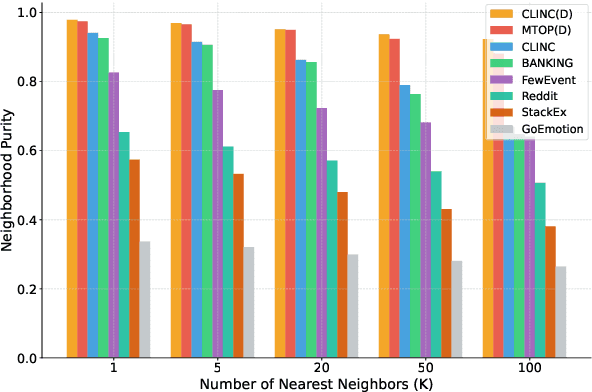
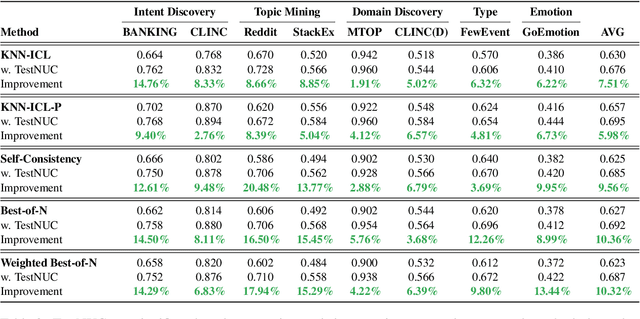
Abstract:Test-time computing approaches, which leverage additional computational resources during inference, have been proven effective in enhancing large language model performance. This work introduces a novel, linearly scaling approach, TestNUC, that improves test-time predictions by leveraging the local consistency of neighboring unlabeled data-it classifies an input instance by considering not only the model's prediction on that instance but also on neighboring unlabeled instances. We evaluate TestNUC across eight diverse datasets, spanning intent classification, topic mining, domain discovery, and emotion detection, demonstrating its consistent superiority over baseline methods such as standard prompting and self-consistency. Furthermore, TestNUC can be seamlessly integrated with existing test-time computing approaches, substantially boosting their performance. Our analysis reveals that TestNUC scales effectively with increasing amounts of unlabeled data and performs robustly across different embedding models, making it practical for real-world applications. Our code is available at https://github.com/HenryPengZou/TestNUC.
Multi-Agent Autonomous Driving Systems with Large Language Models: A Survey of Recent Advances
Feb 24, 2025Abstract:Autonomous Driving Systems (ADSs) are revolutionizing transportation by reducing human intervention, improving operational efficiency, and enhancing safety. Large Language Models (LLMs), known for their exceptional planning and reasoning capabilities, have been integrated into ADSs to assist with driving decision-making. However, LLM-based single-agent ADSs face three major challenges: limited perception, insufficient collaboration, and high computational demands. To address these issues, recent advancements in LLM-based multi-agent ADSs have focused on improving inter-agent communication and cooperation. This paper provides a frontier survey of LLM-based multi-agent ADSs. We begin with a background introduction to related concepts, followed by a categorization of existing LLM-based approaches based on different agent interaction modes. We then discuss agent-human interactions in scenarios where LLM-based agents engage with humans. Finally, we summarize key applications, datasets, and challenges in this field to support future research (https://anonymous.4open.science/r/LLM-based_Multi-agent_ADS-3A5C/README.md).
TabGen-ICL: Residual-Aware In-Context Example Selection for Tabular Data Generation
Feb 23, 2025Abstract:Large Language models (LLMs) have achieved encouraging results in tabular data generation. However, existing approaches require fine-tuning, which is computationally expensive. This paper explores an alternative: prompting a fixed LLM with in-context examples. We observe that using randomly selected in-context examples hampers the LLM's performance, resulting in sub-optimal generation quality. To address this, we propose a novel in-context learning framework: TabGen-ICL, to enhance the in-context learning ability of LLMs for tabular data generation. TabGen-ICL operates iteratively, retrieving a subset of real samples that represent the residual between currently generated samples and true data distributions. This approach serves two purposes: locally, it provides more effective in-context learning examples for the LLM in each iteration; globally, it progressively narrows the gap between generated and real data. Extensive experiments on five real-world tabular datasets demonstrate that TabGen-ICL significantly outperforms the random selection strategy. Specifically, it reduces the error rate by a margin of $3.5\%-42.2\%$ on fidelity metrics. We demonstrate for the first time that prompting a fixed LLM can yield high-quality synthetic tabular data. The code is provided in the \href{https://github.com/fangliancheng/TabGEN-ICL}{link}.
Diffusion-nested Auto-Regressive Synthesis of Heterogeneous Tabular Data
Oct 28, 2024Abstract:Autoregressive models are predominant in natural language generation, while their application in tabular data remains underexplored. We posit that this can be attributed to two factors: 1) tabular data contains heterogeneous data type, while the autoregressive model is primarily designed to model discrete-valued data; 2) tabular data is column permutation-invariant, requiring a generation model to generate columns in arbitrary order. This paper proposes a Diffusion-nested Autoregressive model (TabDAR) to address these issues. To enable autoregressive methods for continuous columns, TabDAR employs a diffusion model to parameterize the conditional distribution of continuous features. To ensure arbitrary generation order, TabDAR resorts to masked transformers with bi-directional attention, which simulate various permutations of column order, hence enabling it to learn the conditional distribution of a target column given an arbitrary combination of other columns. These designs enable TabDAR to not only freely handle heterogeneous tabular data but also support convenient and flexible unconditional/conditional sampling. We conduct extensive experiments on ten datasets with distinct properties, and the proposed TabDAR outperforms previous state-of-the-art methods by 18% to 45% on eight metrics across three distinct aspects.
Can Watermarked LLMs be Identified by Users via Crafted Prompts?
Oct 04, 2024
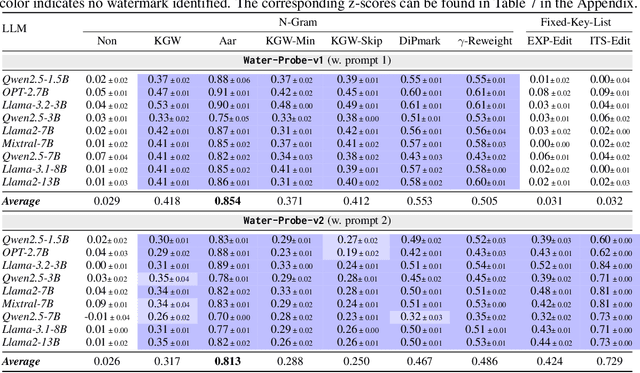


Abstract:Text watermarking for Large Language Models (LLMs) has made significant progress in detecting LLM outputs and preventing misuse. Current watermarking techniques offer high detectability, minimal impact on text quality, and robustness to text editing. However, current researches lack investigation into the imperceptibility of watermarking techniques in LLM services. This is crucial as LLM providers may not want to disclose the presence of watermarks in real-world scenarios, as it could reduce user willingness to use the service and make watermarks more vulnerable to attacks. This work is the first to investigate the imperceptibility of watermarked LLMs. We design an identification algorithm called Water-Probe that detects watermarks through well-designed prompts to the LLM. Our key motivation is that current watermarked LLMs expose consistent biases under the same watermark key, resulting in similar differences across prompts under different watermark keys. Experiments show that almost all mainstream watermarking algorithms are easily identified with our well-designed prompts, while Water-Probe demonstrates a minimal false positive rate for non-watermarked LLMs. Finally, we propose that the key to enhancing the imperceptibility of watermarked LLMs is to increase the randomness of watermark key selection. Based on this, we introduce the Water-Bag strategy, which significantly improves watermark imperceptibility by merging multiple watermark keys.
Do We Really Need Graph Convolution During Training? Light Post-Training Graph-ODE for Efficient Recommendation
Jul 29, 2024



Abstract:The efficiency and scalability of graph convolution networks (GCNs) in training recommender systems (RecSys) have been persistent concerns, hindering their deployment in real-world applications. This paper presents a critical examination of the necessity of graph convolutions during the training phase and introduces an innovative alternative: the Light Post-Training Graph Ordinary-Differential-Equation (LightGODE). Our investigation reveals that the benefits of GCNs are more pronounced during testing rather than training. Motivated by this, LightGODE utilizes a novel post-training graph convolution method that bypasses the computation-intensive message passing of GCNs and employs a non-parametric continuous graph ordinary-differential-equation (ODE) to dynamically model node representations. This approach drastically reduces training time while achieving fine-grained post-training graph convolution to avoid the distortion of the original training embedding space, termed the embedding discrepancy issue. We validate our model across several real-world datasets of different scales, demonstrating that LightGODE not only outperforms GCN-based models in terms of efficiency and effectiveness but also significantly mitigates the embedding discrepancy commonly associated with deeper graph convolution layers. Our LightGODE challenges the prevailing paradigms in RecSys training and suggests re-evaluating the role of graph convolutions, potentially guiding future developments of efficient large-scale graph-based RecSys.
Unleashing the Potential of Diffusion Models for Incomplete Data Imputation
May 31, 2024



Abstract:This paper introduces DiffPuter, an iterative method for missing data imputation that leverages the Expectation-Maximization (EM) algorithm and Diffusion Models. By treating missing data as hidden variables that can be updated during model training, we frame the missing data imputation task as an EM problem. During the M-step, DiffPuter employs a diffusion model to learn the joint distribution of both the observed and currently estimated missing data. In the E-step, DiffPuter re-estimates the missing data based on the conditional probability given the observed data, utilizing the diffusion model learned in the M-step. Starting with an initial imputation, DiffPuter alternates between the M-step and E-step until convergence. Through this iterative process, DiffPuter progressively refines the complete data distribution, yielding increasingly accurate estimations of the missing data. Our theoretical analysis demonstrates that the unconditional training and conditional sampling processes of the diffusion model align precisely with the objectives of the M-step and E-step, respectively. Empirical evaluations across 10 diverse datasets and comparisons with 16 different imputation methods highlight DiffPuter's superior performance. Notably, DiffPuter achieves an average improvement of 8.10% in MAE and 5.64% in RMSE compared to the most competitive existing method.
 Add to Chrome
Add to Chrome Add to Firefox
Add to Firefox Add to Edge
Add to Edge